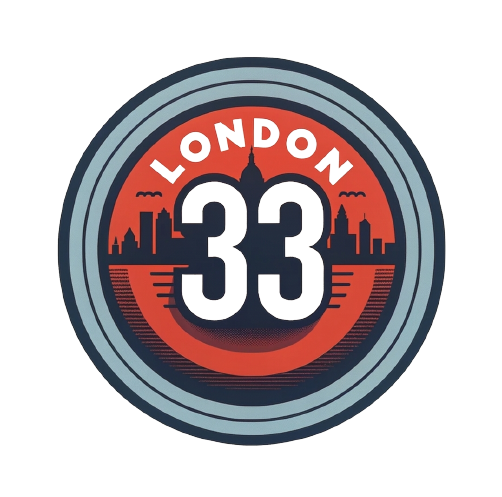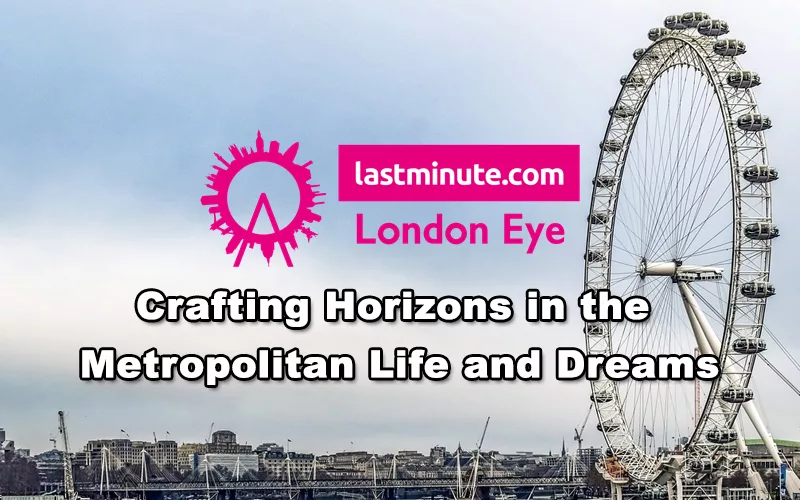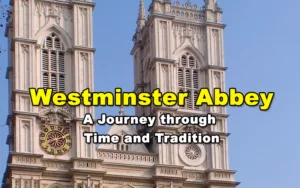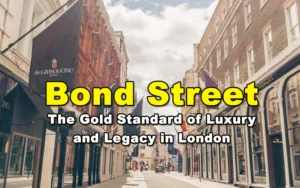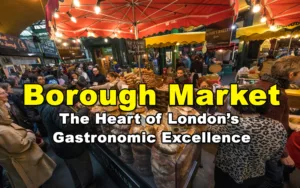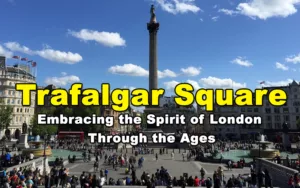Perched gracefully on the south bank of the River Thames, the London Eye emerges not merely as a gigantic observation wheel but as an iconic symbol of the pulsating metropolis that is London. Officially opened to the public on March 9, 2000, the London Eye, initially erected to celebrate the millennium, swiftly transcended its initial purpose, embedding itself as a timeless element within the city’s vibrant skyline.
With an imposing height of 135 meters (443 feet) and encapsulating 32 sealed and air-conditioned passenger capsules, this monumental wheel offers a serene, gradually unfolding panorama of the city, revealing layers upon layers of architectural splendours and secret spots hidden within London’s bustling landscape.
For both the city and its flux of tourists, the London Eye spins more than just awe-inspiring vistas; it weaves a significant web of economic, cultural, and social contributions. Annually, it attracts millions of visitors, each seeking to capture a glimpse of the city from an unrivalled vantage point, thereby substantively fuelling the local tourism industry.
The Eye has not only revolutionized the way in which spectators perceive and experience the city but has also become a central figure around which numerous social and celebratory events orbit, illustrating its integral role in the collective consciousness and functionality of London.
Intricately intertwined with the city’s contemporary identity, this article endeavors to explore the multifaceted appeal of the London Eye, voyaging through its engineering marvel, peeling back layers of its historic significance, and immersing into the breath-taking views it generously unveils. Together, let’s embark on a journey that spirals from its steel structures and panoramic vistas to the symbolic and tangible impact it casts upon the city of London and beyond.
Historical Background To The London Eye
Origins and Reasons Behind its Construction
Journeying back to its inception, the London Eye was conceived from the innovative minds of architects David Marks and Julia Barfield, a husband-wife duo who envisioned a temporary structure to commemorate the new millennium, marking London’s celebration of the year 2000 with spectacular prominence.
The initial purpose was not merely to create a new tourist attraction but to craft a symbol that could encapsulate the spirit of a time – where technology, innovation, and forward-looking optimism converged. Heralding an era of advancements, the Eye was envisaged to reflect both the historical richness and the modernity of London, seamlessly bridging the past, present, and future through its cyclical motion.
Overview of its Official Opening and Initial Public Reception
Despite a slew of technical, financial, and bureaucratic challenges during its construction phase, the London Eye triumphantly opened its capsules to the public on March 9, 2000. Initially, there were skeptics, pondering over its longevity and fearing it might end up as a white elephant post-celebrations. However, the public reception proved these apprehensions unfounded.
The London Eye was instantaneously embraced by both Londoners and tourists alike, with its initial year attracting over 3 million visitors. The magnificence of the views, coupled with the novelty of the experience, captivated the hearts of many, swiftly cementing its position as one of the most sought-after tourist destinations and an esteemed symbol of the city.
The Symbolic Meaning of the London Eye
As the wheel gently rotates, it bears witness to the sprawling tapestry of London beneath, becoming a metaphoric and physical representation of time’s ceaseless march. The London Eye stands as a sentinel, graciously symbolizing the cyclical nature of history, where every end is tethered to a new beginning. It’s a symbol of unity, bringing people from varied walks of life into a single, encapsulated experience of shared vistas and collective awe.
Moreover, it embodies innovation and architectural prowess, reflecting the city’s continual growth and its unyielding spirit of evolution and progression. In its unbroken, continual rotation, the Eye whispers of constancy amidst change, offering a stable, albeit ever-moving, platform from which to gaze out upon the shifting world.
As we voyage through the annals of history and observe the steady turn of the London Eye, we discover not just an architectural marvel, but a symbolic entity that mirrors the collective aspirations, steady progression, and indomitable spirit of the city it gracefully observes. Thus, the Eye is not merely a spectator but an active participant in the ever-unfolding story of London, elegantly threading the city’s historic past with its evolving present and anticipated future.
Architectural and Engineering Marvel of the London Eye
Exploration of the Unique Design and Structure
1. Ferris Wheel Design and Construction Materials
Positioned elegantly alongside the River Thames, the London Eye, often referred to as the Millennium Wheel, introduces a contemporary take on the classic Ferris wheel design. It brandishes a cantilevered structure, supported on one side only, with an A-frame configuration that distinguishes it from traditional wheels.
The skeletal structure, crafted with meticulous precision, employs a combination of steel for its robustness and glass for the capsules, providing an unhindered, 360-degree view of the city. The materials were judiciously chosen not only for structural integrity but also to minimize the visual barrier, ensuring that the Eye compliments rather than obscures the city’s historic skyline.
2. Technical Specifications and Innovations
Boasting a diameter of approximately 120 meters and an awe-inspiring height of 135 meters, the Eye was once the world’s tallest observation wheel until 2006. Housing 32 ovoidal capsules, each capable of accommodating up to 25 passengers, the wheel turns slow enough to allow passengers to embark while it is moving, a reflection of its design ingenuity.
Innovatively, the capsules are externally mounted to the wheel’s structure, ensuring a panoramic view without mechanical obstructions, and are rotated using electric motors to keep the floor level stable and secure throughout the journey.
Engineering Achievements and Challenges During Construction
The conception and construction of the London Eye were littered with remarkable engineering feats and formidable challenges. One notable hurdle was the wheel’s “rotation” to its upright position, which was executed over several days, utilizing a process known as “progressive jacking” and was accomplished without the assistance of a supporting scaffold, a technique never before employed on such a scale.
The unconventional, cantilevered structure also posed significant engineering conundrums, demanding innovative solutions to ensure stability without compromising aesthetics. Despite numerous technical and bureaucratic obstacles, the engineering and construction teams meticulously adapted, ensuring the Eye not only stood tall but also operated smoothly, mirroring the dynamic yet steady essence of London itself.
Safety Features and Maintenance Protocols
The London Eye not only stands as a testament to architectural prowess but also exemplifies stringent safety and maintenance standards. Each capsule is fitted with bench seating and is fully air-conditioned to ensure comfort and safety. Furthermore, it features an extensive range of safety features including manual and automatic capsule door systems and sophisticated electronic monitoring systems to track the structural health of the wheel.
Annual maintenance periods are embedded into its operational calendar, where rigorous checks and updates are performed to ensure its continual safe operation. Each element, from the structural components to the moving parts, is scrupulously inspected and maintained, safeguarding its integrity and the safety of its passengers.
In encapsulation, the London Eye emerges not merely as an observational wheel but as an embodiment of pioneering architectural and engineering triumph, marrying form and function with a delicate grace that enchants every onlooker and passenger. It invites us to marvel not just at the city it observes but also at the audacity, ingenuity, and skill which brought it into existence.
Experiencing the London Eye
A Journey through the Capsules
1. Description of the Capsule Experience
The adventure begins the moment one steps into the streamlined, futuristic capsules of the London Eye. The gradual ascent into the London sky is both serene and thrilling as the capsules, made predominantly of glass, afford an uninterrupted view, subtly shifting the panorama from bustling streets to a sprawling urban horizon.
The slow rotation provides ample time (approximately 30 minutes) for passengers to absorb the spectacle, capturing memories or simply basking in the awe-inspiring views. With each gentle turn of the wheel, landmarks, both famed and hidden, unfold in a new light, as visitors navigate through the beautifully choreographed dance of history and modernity below.
2. Overview of the Views and Sights from Atop
As the capsule ascends, an unfolding tableau of London’s iconic sights unveils itself. From the historic Houses of Parliament and the majestic Buckingham Palace to the modern Shard and the serpentine River Thames weaving through the city, each sight offers a unique perspective, blending the rich tapestry of London’s past, present, and future. The Eye, from its pinnacle, provides a bird’s-eye view, wherein the city’s architectural marvels, green spaces, and lively boroughs converge into a spectacular visual symphony.
Special Events and Capsules
The London Eye has played host to various notable events and celebrations, transforming itself into a vibrant platform where the city comes together to commemorate occasions, both festive and solemn. Be it the spectacular New Year’s Eve firework displays or themed events, the Eye embraces and enhances the collective spirit of the celebrations, illuminating the London sky with its dynamic lighting and becoming a focal point of citywide festivities.
Private Capsule Bookings for Special Occasions
The London Eye’s capsules have witnessed countless personal moments and celebrations – from proposals and weddings to birthday milestones. Private capsules can be booked, offering an intimate setting amid the London skyline, complete with tailored experiences like champagne toasts, private guides, and personalized decorations, making every moment spent aboard truly enchanting and distinctly personal.
Visitor Information for the London Eye
Tickets and Pricing
Varied ticket options cater to diverse visitor preferences, ranging from standard tickets to fast-track options and even combination tickets that bundle the Eye experience with other notable London attractions. Pricing and packages can typically be explored and purchased on the official London Eye website or through authorized dealers, often with online booking options providing a seamless pre-visit experience.
Operational Hours and Best Times to Visit
While operational hours can fluctuate based on seasons and special events, a general guide is to plan visits during mid-morning or late afternoon to evade peak crowds. Seasonally, spring and summer offer vibrant vistas, while the winter months, particularly during the festive season, provide a uniquely illuminated view of the city.
Accessibility and Facilities
The London Eye prides itself on being accessible, offering disabled access throughout and ensuring every visitor, irrespective of physical ability, can revel in the experience. Facilities such as nearby eateries, gift shops, and customer service booths further enhance the visitor experience, ensuring convenience and comfort during the adventure.
Embarking on a journey with the London Eye offers more than mere sights; it encapsulates moments where London’s essence can be truly felt and experienced, creating memories that linger far beyond the descent back to the ground.
The London Eye in Popular Culture
Appearances and References in Films and Television
The London Eye, with its distinctive and arresting presence, has seamlessly embedded itself into the visual and narrative realms of films and television. From becoming a backdrop that inherently symbolizes its home city, as seen in popular films like “Fantastic Beasts and Where to Find Them” and “London Has Fallen,” to playing a crucial role in plot narratives, such as in “Doctor Who”, where it was instrumental in a storyline involving an alien invasion.
The Eye has become synonymous with the cityscape of London, often utilized to immediately place a story within the vibrant, dynamic heartbeat of the capital, imparting narratives with an embedded sense of locale and cultural identity.
Influence on Art, Literature, and Music
The Eye’s influence permeates beyond the screen, casting its shadow across various forms of art, literature, and music, symbolizing both the city and the themes of time, observation, and continuity. Novelists, painters, and musicians have drawn inspiration from its omnipresent rotation and iconic silhouette. In literature, it has become a metaphor for the cyclical nature of life and time.
Artists have captured its essence through various mediums, reflecting its multifaceted persona that ranges from stoic observer to vibrant celebrator. Musicians, through lyrics and music videos, have utilized the Eye as a symbol of the city’s rhythm, its cultural pulse, and its enduring spirit, crafting melodies that intertwine with the visual and emotional resonance that the structure inherently exudes.
Celebratory Events and Yearly Traditions Associated with the Eye
Rooted in the cyclical celebrations that mark the passage of time, the London Eye has become a central figure in various celebratory events and yearly traditions. Most notably, it plays a pivotal role in London’s New Year’s Eve celebrations, acting as the focal point for one of the world’s most watched firework displays.
Beyond the spectacles of light during festive seasons, the Eye has also been illuminated in various colors to mark specific days and causes, such as lighting up in rainbow hues for Pride in London or turning pink for Breast Cancer Awareness Month. Additionally, the annual rotation of the Eye has hosted numerous charity events and city celebrations, intertwining its existence with the collective memories and shared moments of the city and its inhabitants.
Through its silent observation and ceaseless rotation, the London Eye transcends its physical form, spiraling into various facets of popular culture, becoming a symbol, a muse, and a shared point of reference that connects narratives, expressions, and collective celebrations across diverse mediums and contexts.
This exploration of its presence within popular culture illustrates not merely an architectural marvel but a cultural icon that continuously narrates London’s ever-evolving story.
Economic and Social Impact of the London Eye
Contribution to London’s Tourism Industry
Since it first opened its doors in 2000, the London Eye has become a cornerstone of the city’s bustling tourism scene. Every year, it pulls in millions of people from all corners of the world, standing not only as a symbolic landmark but also as a powerful economic engine that pumps significant revenue into the area.
Visitors often explore nearby neighborhoods too, pouring extra money into various industries like hotels, shops, and transport. Additionally, the Eye is a key player in marketing, often featured in campaigns to draw in tourists, thereby subtly bolstering and boosting London’s charm as a must-visit global hotspot.
Role in Community Events and Public Gatherings
The London Eye has ingrained itself into the social fabric of the city, often serving as a communal space that fosters social interactions and collective experiences. It has hosted, and been the backdrop for, numerous public gatherings, celebrations, and events, from the exuberant New Year’s Eve celebrations to serene silent discos that have taken place in its capsules.
It has also been a symbol of unity and solidarity during various civic movements and events, illuminating its structure to echo the sentiments of the populace and stand as a beacon during pivotal moments in the city’s social and cultural narrative.
Implications on Local Businesses and Employment
Beyond being a tourist magnet, the London Eye significantly impacts local businesses and employment in its vicinity and beyond. The influx of visitors ensures a continual demand for services such as dining, shopping, and accommodation, thereby supporting numerous local enterprises and establishments.
From souvenir shops to quaint cafes, the bustling area surrounding the Eye thrives on the continual footfall generated by its presence. Furthermore, the operation, maintenance, and management of the Eye itself create numerous employment opportunities, ranging from technical roles to customer service, management, and administrative positions. The cascade of its economic impact, therefore, permeates various layers of the local economy, generating employment, supporting businesses, and contributing to the financial sustainability of the region.
The London Eye, while often revered for its architectural and cultural prominence, simultaneously casts a wide-reaching economic and social influence. Its impact, reverberating across tourism, community dynamics, and local economic ecosystems, underscores its significance as not merely an observational wheel but a pivotal entity that intertwines with the multifaceted economic and social tapestry of London. This aspect of the Eye amplifies its stature from an architectural marvel to an integral component that propels both the economic and social vigour of the city.
Criticisms and Controversies Related to the London Eye
Overview of the Debates Surrounding its Construction
The inception and realization of the London Eye were not devoid of debates and disagreements. During its planning and construction phases, various parties raised concerns and objections, influencing public discourse and shaping the project’s journey. Critics from architectural circles, historical preservation groups, and some local residents expressed reservations about its potential impact on the iconic London skyline and the preservation of the city’s historic character.
Legal and bureaucratic hurdles also punctuated its journey, with planning permissions, safety concerns, and aesthetic debates often percolating through its development trajectory, illustrating that its establishment was a matter of intricate negotiation and compromise among varied interests and perspectives.
Environmental Concerns and Sustainability Issues
Environmental advocates and sustainability experts have spotlighted the London Eye with regard to its ecological footprint and sustainability practices. Questions concerning its energy consumption, waste management, and overall environmental impact have been subjects of discussion and critique.
Additionally, considerations regarding its influence on local ecosystems, particularly given its proximity to the River Thames, have been explored, prompting discussions around sustainability and environmentally-friendly operational practices. Over time, these considerations have steered modifications and initiatives aimed at reducing its environmental impact and aligning its operations with emerging sustainability norms and expectations.
Public Opinion and Criticisms over the Years
Public opinion regarding the London Eye has been a mosaic of admiration, curiosity, and critique. While many celebrate it as a symbol of modern London, providing the city with a fresh architectural narrative and a novel vantage point, others perceive it as a commercial entity that potentially detracts from the sanctity and aesthetic of the historic environs.
Criticisms have also spanned aspects such as ticket pricing, accessibility, and the experiences offered, reflecting the diverse expectations and experiences of its myriad visitors. Additionally, debates have unfurled regarding its role and representation in the cultural and social dimensions of the city, intertwining it with broader discussions regarding urban development, heritage preservation, and public space utilization in the metropolis.
Though encapsulated within its serene rotation are stories of controversies and criticisms that the London Eye has navigated since its conceptual stages, providing a rich and complex narrative that goes beyond its visual and experiential offerings.
It stands as a testament to the dynamic interplay of innovation, public discourse, and adaptive practices that shape and define modern urban landmarks. This facet of the Eye provides a multifaceted lens through which to explore the complex, often contentious, pathways that intertwine to define, challenge, and re-imagine the physical and cultural landscapes of cities.
Summing Up the London Eye
Recapitulation of Key Points
Embarking upon a panoramic journey through its rich history, architectural mastery, experiential offerings, cultural imprints, socio-economic impacts, critical dialogues, and envisioned future, the London Eye emerges as more than an observational wheel.
It represents a complex, multifaceted entity that intertwines with London’s cultural, social, and economic narratives, playing varied roles from silent observer to vibrant celebrator, from economic catalyst to symbol of unity and continuity.
Final Thoughts on the Cultural and Symbolic Value of the London Eye
In its ceaseless rotations, the London Eye has become an embodiment of London itself – diverse, enduring, and continually evolving. Beyond its physical form, it spins a myriad of stories and experiences, embodying the pulses and rhythms of the city it inhabits.
The Eye, in its symbolic stature, entwines the historical with the contemporary, offering not only breath-taking views but also providing a vantage point from which to observe and reflect upon the city’s evolving narratives and trajectories. Its cultural and symbolic value permeates various dimensions, from being a testament to architectural and engineering prowess to becoming an intrinsic element within London’s cultural, social, and visual tapestry.
Encouraging Continued Exploration and Appreciation
The stories and experiences that encircle the London Eye invite continued exploration and appreciation from both inhabitants of and visitors to the city. As it continues to etch its presence into London’s skyline and shared experiences, the Eye prompts explorations that go beyond its visual and experiential offerings, delving into the layered narratives, debates, and future visions that it is embedded within.
The continued journey of the Eye, interlaced with challenges, enhancements, and evolving roles within the city’s tapestry, invites observers to become explorers, uncovering and partaking in the multifaceted, continually unfolding stories that it both observes and partakes in.
In conclusion, the London Eye, through its silent rotations and commanding presence, invites reflections, explorations, and anticipations that transcend its structural form, encouraging an appreciation that encompasses its historical journeys, present experiences, and future pathways.
It stands not merely as a point from which to observe the city but as an entity that prompts observation, reflection, and exploration of the myriad stories, debates, and visions that weave through the vibrant, dynamic metropolis it calls home. The Eye, in its multifaceted appeal and significance, continues to weave a rich, complex narrative that invites continued exploration, appreciation, and collective storytelling within the pulsating heart of London.
“I may earn commissions as an affiliate from sponsored links within this post”
